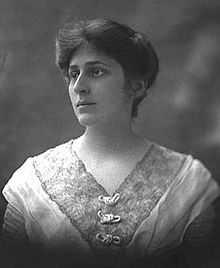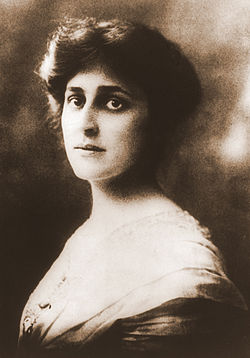- Crystal Eastman
-
Crystal Eastman 
Crystal Eastman, feminist and political activistBorn June 25, 1881
Marlborough, MassachusettsDied July 8, 1928 Nationality American Occupation Lawyer Known for Feminism, socialism, The Liberator, and as a co-founder of the Women's International League for Peace and Freedom Spouse Walter Fuller Children Jeffrey Fuller and Annis Fuller Crystal Catherine Eastman (June 25, 1881 – July 8, 1928)[1] was a lawyer, antimilitarist, feminist, socialist, and journalist. She is best remembered as a leader in the fight for women's right to vote, as a co-editor of the radical arts and politics magazine The Liberator, and as a co-founder of the Women's International League for Peace and Freedom.
Contents
Biography
Early years
Crystal Eastman was born in Marlborough, Massachusetts on June 25, 1881. Her parents, Samuel Elijah Eastman and Annis Bertha Ford, were both Congregational Church clergy, and together served as pastors at the church of Thomas K. Beecher near Elmira, New York. In 1889, her mother had become one of the first women ordained as a Protestant minister in America. This part of New York was in the so-called "Burnt Over District," which earlier in the 19th century had generated much religious excitement, including the formation of the Mormon movement, and social causes, such as abolitionism and support for the Underground Railroad. Her parents were friendly with the writer Mark Twain, and from this association young Crystal herself became acquainted with Twain.
She was the sister of the socialist activist Max Eastman, with whom she was quite close throughout her life.[2]
Eastman graduated from Vassar College in 1903 and received an M.A. in sociology from Columbia University in 1904. Receiving her law degree from New York University Law School, she graduated second in the class of 1907.[3][1]
Social efforts
Social work pioneer and journal editor Paul Kellogg offered Eastman her first job, investigating labor conditions for The Pittsburgh Survey sponsored by the Russell Sage Foundation.[4][1] Her report, Work Accidents and the Law (1910), became a classic and resulted in the first workers' compensation law, which she drafted while serving on a New York state commission.[1]
She continued to campaign for occupational safety and health while working as an investigating attorney for the U.S. Commission on Industrial Relations during Woodrow Wilson's presidency. She was at one time called the "most dangerous woman in America," due to her free-love idealism and outspoken nature.
Emancipation
During a brief marriage to Wallace J. Benedict which ended in divorce, Eastman lived in Milwaukee and managed the unsuccessful 1912 Wisconsin suffrage battle.[2]
When she returned east in 1913 she joined Alice Paul, Lucy Burns, and others in founding the militant Congressional Union, which became the National Woman's Party. After the passage of the 19th Amendment gave women the vote in 1920, Eastman and three others wrote the Equal Rights Amendment, first introduced in 1923. One of the few socialists to endorse the ERA, she warned that protective legislation for women would mean only discrimination against women. Eastman claimed that one could assess the importance of the ERA by the intensity of the opposition to it, but she felt that it was still a struggle worth fighting.
Peace efforts
During World War I, Eastman was one of the founders of the Woman's Peace Party, soon joined by Jane Addams, Lillian D. Wald, and others.[5] She served as president of the New York branch. Renamed the Women's International League for Peace and Freedom in 1921, it remains the oldest extant women's peace organization. Eastman also became executive director of the American Union Against Militarism, which lobbied against America's entrance into the European war and more successfully against war with Mexico in 1916, sought to remove profiteering from arms manufacturing, and campaigned against conscription and imperial adventures. When the United States entered World War I, Eastman organized with Roger Baldwin and Norman Thomas the National Civil Liberties Bureau to protect conscientious objectors, or in her words: To maintain something over here that will be worth coming back to when the weary war is over. The NCLB grew into the American Civil Liberties Union, with Baldwin at the head and Eastman functioning as attorney in charge. Eastman is credited as a founding member of the ACLU, but her role as founder of the NCLB may have been largely ignored by posterity due to her personal differences with Baldwin.[3]
In 1916 Eastman married British editor and antiwar activist Walter Fuller.[2] They had two children, Jeffrey and Annis. They work together until the end of the war, when he returned to England to find work.
Post-War
In 1917, Eastman co-founded a radical journal of politics, art, and literature, The Liberator, with her brother Max.[2] She served as managing editor from 1917 to 1921.[6]
After the war, Eastman organized the First Feminist Congress in 1919.
She commuted between London to be with her husband, and New York, where she was blacklisted and thus rendered unemployable during the Red Scare of 1919-1920.
During the 1920s her only paid work was as a columnist for feminist journals, notably Equal Rights and Time and Tide. Eastman claimed that "life was a big battle for the complete feminist," but she was convinced that the complete feminist would someday achieve total victory.
Death
Crystal Eastman died on July 8, 1928, of nephritis.[3]
Legacy
Eastman has been called one of the United States' most neglected leaders, because, although she wrote pioneering legislation and created long-lasting political organizations, she disappeared from history for fifty years. In 2000 she was inducted in the (American) National Women's Hall of Fame in Seneca Falls, New York. Freda Kirchwey, then editor of The Nation, wrote at the time of her death: "When she spoke to people—whether it was to a small committee or a swarming crowd—hearts beat faster. She was for thousands a symbol of what the free woman might be."[3]
Work
Papers
Eastman's papers are housed at Harvard University.[7]
Publications
The Library of Congress has the following publications by Eastman in its collection, much of it published posthumously:
- "Employers' liability," a criticism based on facts (1909)
- Work-accidents and the law (1910)
- Mexican-American Peace Committee (Mexican-American league) (1916)
- Work accidents and the law (1969)
- Toward the great change: Crystal and Max Eastman on feminism, antimilitarism, and revolution, edited by Blanche Wiesen Cook (1976)
- Crystal Eastman on women and revolution, edited by Blanche Wiesen Cook (1978)
Footnotes
- ^ a b c d "Crystal Eastman". Encyclopedia Brittanica. http://www.britannica.com/EBchecked/topic/177433/Crystal-Eastman. Retrieved 18 October 2011.
- ^ a b c d "Crystal Eastman". National Women's History Museum. http://www.nwhm.org/education-resources/biography/biographies/crystal-eastman/. Retrieved 18 October 2011.
- ^ a b c d "Crystal Eastman". Vassar College: Innovators. http://innovators.vassar.edu/innovator.html?id=23. Retrieved 18 October 2011.
- ^ "Labor Center: Crystal Eastman". Indiana University of Pennsylvania. http://www.iup.edu/page.aspx?id=60999. Retrieved 18 October 2011.
- ^ "Women and Peace: The Legacy". Ms. Magazine. http://www.msmagazine.com/winter2006/legacy.asp. Retrieved 18 October 2011.
- ^ "Crystal Eastman (1881-1928): Radical Feminist from Greenwich Village". College of Staten Island/CUNY. http://www.library.csi.cuny.edu/dept/history/lavender/386/ceastman.html. Retrieved 18 October 2011.
- ^ "Eastman, Crystal, 1881-1928. Papers, 1889-1931: A Finding Aid". Harvard University Library. http://oasis.lib.harvard.edu/oasis/deliver/~sch00562. Retrieved 9 September 2011.
See also
People
- Alice Paul
- Lucy Burns
- Jane Addams
- Lillian D. Wald
- Roger Baldwin
- Norman Thomas
- Walter Fuller
- Jeffrey Fuller
- Max Eastman
Political groups
Other
- The Pittsburgh Survey
- Workers' compensation
- U.S. Commission on Industrial Relations
- 1912 Wisconsin suffrage battle
- 19th Amendment
- Equal Rights Amendment
- The Liberator
Additional reading
- Blanche Wiesen Cook, ed., Crystal Eastman on Women and Revolution. (1978).
External links
- Crystal Eastman Papers Finding Aid, Schlesinger Library, Radcliffe Institute, Harvard University.
Categories:- 1881 births
- 1928 deaths
- American anti-war activists
- American Civil Liberties Union
- American female lawyers
- American feminists
- American magazine editors
- American pacifists
- American socialists
- American suffragists
- Columbia University alumni
- Vassar College alumni
Wikimedia Foundation. 2010.

